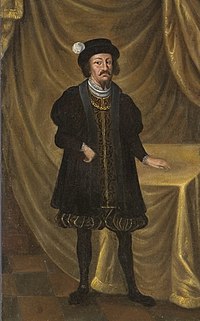Magnus I of Saxe-Lauenburg
| Magnus I | |
|---|---|
| Duke of Saxe-Lauenburg | |

Magnus I (ca. 1520)
|
|
| Duke of Saxe-Lauenburg | |
| Reign | 1507–1543 |
| Predecessor | John V, Duke of Saxe-Lauenburg |
| Successor | Francis I, Duke of Saxe-Lauenburg |
| Born |
1 January 1470 Ratzeburg |
| Died | 1 August 1543 (aged 73) Ratzeburg |
| Burial | Ratzeburg |
| Consort | Catherine of Brunswick-Wolfenbüttel |
| Issue Detail |
Francis I Dorothea, Queen of Denmark Catherine, Queen of Sweden Clara, Duchess of Brunswick-Giffhorn Sophia, Countess of Oldenburg-Delmenhorst Ursula, Duchess of Mecklenburg-Schwerin |
| House | Ascania |
| Father | John V, Duke of Saxe-Lauenburg |
| Mother | Dorothea of Brandenburg |
| Religion | Roman Catholic until 1531, thereafter Lutheran |
Magnus I of Saxe-Lauenburg (Ratzeburg, 1 January 1470 – 1 August 1543, Ratzeburg) was a Duke of Saxe-Lauenburg from the House of Ascania.
Magnus was the second son of John V, Duke of Saxe-Lauenburg and Dorothea of Brandenburg, daughter of Frederick II, Elector of Brandenburg.
In 1481 John V redeemed Saxe-Lauenburg's exclave Land of Hadeln, which had been pawned to Hamburg as security for a credit of 3,000 Rhenish guilders since 1407. John V then made his son and heir apparent, Magnus, vicegerent of Hadeln, and finally regent as of 1498.
In 1484 Magnus, who aimed at increasing his local revenues, had reached out to conquer the rich neighbouring Land of Wursten, a de facto autonomous region of free Frisian peasants in a North Sea marsh at the Weser estuary, but he failed Magnus tried to justify his violent act with the pretence that Wursten used to be Saxon before the imperial deposition of Duke Henry the Lion and the carve-up of his Duchy of Saxony in 1180, which only brought Magnus' Ascanian dynasty to take the belittled dukedom. The Prince-Archbishopric of Bremen, claiming Wursten for itself, was alarmed.
After becoming Regent Magnus planned a new conquest of Wursten. On 24 November 1498 Magnus allied with his father and Henry IV, Duke of Brunswick-Lüneburg to conquer Wursten. Henry IV obliged to send 3,000 lansquenets, who should gain their payment by ravaging and plundering the free peasants of Wursten, once successfully subjected. Bremen's Prince-Archbishop Johann Rode had prepared for this, he and Hamburg's three burgomasters (upcoming, presiding, and outgoing), Johannes Huge, Hermen Langenbeck and Henning Buring had concluded a defensive alliance on 16 November. Hamburg feared for its exclave Ritzebüttel, its military outpost at the Outer Elbe to defend the free access to Hamburg via Elbe, thus the city became the driving force in preparing everything for Magnus' eventual attack.
...
Wikipedia
